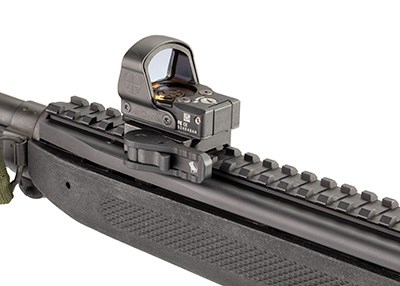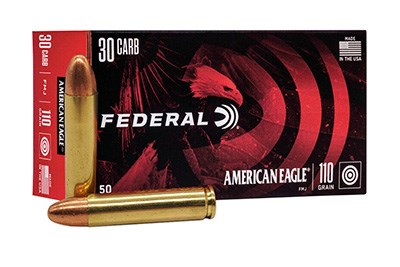Updating An M1 Carbine
Made in great numbers—more than 6 million—the M1 carbine served American forces admirably from World War II well into the Vietnam War. It even spawned commercial variants—some of which are currently available. And while many agree that the U.S. military’s “light rifle” served with distinction, a few also credit it as the first-ever personal defense weapon (PDW)—a chambering-based category that lies between pistol-caliber carbines and rifles chambered for intermediate-power cartridges. It is a concept for which there are few examples, yet is particularly applicable to the modern home defender, rancher or recreational shooter.
 I was generally dismissive of the M1 carbine until recently when I came into possession of a 1944-manufactured Winchester example that once belonged to my late father. An Arlington Ordnance import from Korea, it had been rebuilt by a friend and my brother when they were employed at that now-defunct company. The Winchester-marked barrel that was ultimately selected for the build bears the name of another entity that imported M1 rifles and carbines at that time, Blue Sky, and all of the other components are period-correct for a late-war Winchester.
I was generally dismissive of the M1 carbine until recently when I came into possession of a 1944-manufactured Winchester example that once belonged to my late father. An Arlington Ordnance import from Korea, it had been rebuilt by a friend and my brother when they were employed at that now-defunct company. The Winchester-marked barrel that was ultimately selected for the build bears the name of another entity that imported M1 rifles and carbines at that time, Blue Sky, and all of the other components are period-correct for a late-war Winchester.
The gun’s sentimental value far outweighs its historical significance in my mind, so I decided to give it a new lease on life. And considering that such endeavors are shunned by collectors, I was determined to demonstrate that it can be done without gunsmithing and, therefore, without permanent alterations to the gun. So, after carefully setting aside the original parts, I endeavored to make the little American-made classic even handier and more shootable—using all U.S.-made components.
- Buy All-American!
- Bring health and vitality back to your body with these non-transdermal patches
- Get your Vitamin B17 & Get 10% Off With Promo Code TIM
- How To Protect Yourself From 5G, EMF & RF Radiation - Use promo code TIM to save $$$
- The Very Best All-American Made Supplements On The Maret
- Grab This Bucket Of Heirloom Seeds & Save with Promo Code TIM
- Here’s A Way You Can Stockpile Food For The Future
- Stockpile Your Ammo & Save $15 On Your First Order
- Preparing Also Means Detoxifying – Here’s One Simple Way To Detoxify
- The Very Best Chlorine Dioxide
- All-American, US Prime, High Choice Grass-Fed Beef with NO mRNA, hormones or antibiotics... ever!
The first order of business was a folding stock, although I found the reproduction M1A1 paratrooper designs and post-war commercial underfolders to be both awkward and scarce. Also, since I prefer folders that swing to the right, Choate’s polymer M1 Military Side Fold ($135, riflestock.com) quickly became the obvious choice.
The second major upgrade involved adding a Picatinny rail for use with optics. For that, I turned to the Ultimak .30 M1 Carbine Scout Mount ($96, ultimak.com), which is available for both G.I.- and commercial-pattern guns in either full Picatinny or partial-Picatinny/Direct Attachment versions. It does require minor inletting of the Choate sidefolder’s fore-end channel, but Ultimak makes that easy by offering the already-modified stock for sale directly.
 While the carbine has an excellent set of open sights—in this case including the milled, quick-adjustable rear—I wanted to mount either a red-dot or low-power scope. So, in keeping with the U.S.-made and lightweight themes, I chose a Leupold DeltaPoint Pro with 2.5-m.o.a. dot ($450, leupold.com) fitted with an American Defense Mfg. AD-TR-STD quick-release mount ($83, admmfg.com). Its position on the Picatinny rail allows me to grab the carbine between the optic and magazine for one-handed carry at the side, and reverting to the irons requires only a simple throw of the mount’s lever.
While the carbine has an excellent set of open sights—in this case including the milled, quick-adjustable rear—I wanted to mount either a red-dot or low-power scope. So, in keeping with the U.S.-made and lightweight themes, I chose a Leupold DeltaPoint Pro with 2.5-m.o.a. dot ($450, leupold.com) fitted with an American Defense Mfg. AD-TR-STD quick-release mount ($83, admmfg.com). Its position on the Picatinny rail allows me to grab the carbine between the optic and magazine for one-handed carry at the side, and reverting to the irons requires only a simple throw of the mount’s lever.
The resulting “enhanced” M1 carbine tops out at 7 lbs. exactly with an empty 15-round magazine in place, and, when it came time to test it, I was pleased to find that it travels discreetly in a short case and slings easily front or back with the stock folded—coming to the shoulder quickly when extended. Also, the Leupold red-dot seems to land instinctively on target. Finally, after sampling several varieties of ammunition, I was pleasantly surprised to find that the carbine groups five shots into 0.567″ at 50 yards using Federal American Eagle 110-grain FMJ ammunition.
While I know that many M1 carbine owners would never consider such modifications to a wartime gun with significant provenance, those who have run-of-the-mill arsenal-rebuilt or commercial examples, and who are willing to experiment, are likely to find that the M1 carbine can provide service comparable to modern PDW-type platforms—nearly 85 years after it was first conceived.
—Brian C. Sheetz, Editor In Chief
Article by BRIAN C. SHEETZ, EDITOR IN CHIEF
Don't forget to like us on Facebook and follow us on Twitter.














